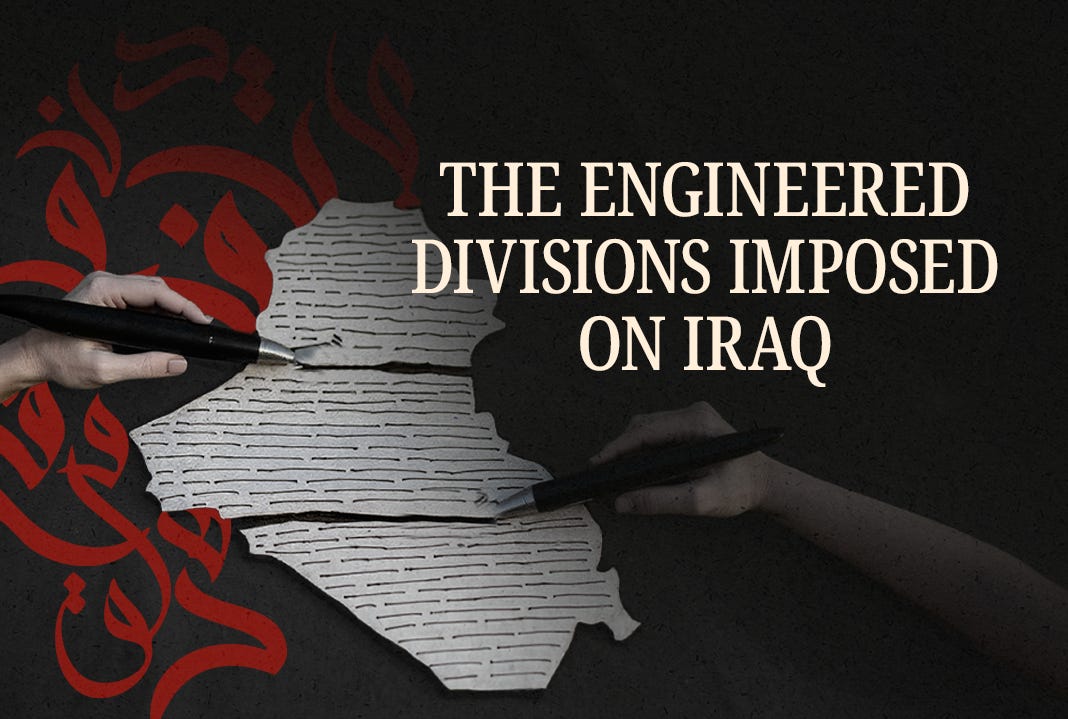The Engineered Divisions Imposed on Iraq
The country’s sectarian strife is less a product of history than a legacy of foreign interference
Sectarianism in Iraq is often mischaracterized as a long-standing divide that has always shaped Iraqi society—an ancient animosity embedded in the nation’s social fabric. But this narrative obscures a more accurate history. The sectarian divisions that define modern Iraq are not indigenous or inevitable; instead, they are the legacy of foreign interventions that weaponized identity to entrench power. Far from being the natural outcome of internal dynamics, sectarianism in Iraq was manufactured over centuries through imperial manipulation, deliberate marginalization, and externally imposed conflict.
Until the early modern era, sectarian affiliation in Iraq was a matter of private belief rather than political alignment. Communal life was shaped more by tribal, familial, and local affiliations than by whether one was Sunni or Shia. Urban centers like Baghdad, Najaf, and Kufa flourished as hubs of cultural and religious pluralism, home to Arabs, Kurds, Persians, Jews, Christians, and Muslims of varying sects.
Theological distinctions certainly existed, but they did not manifest as political fault lines. The concept of "sectarianism" (ta’ifiya)—the division of society and politics along religious or sect-based lines—had little relevance to governance or social hierarchy in pre-modern Iraq. Religious institutions operated autonomously, tribal networks remained inclusive, and identity was fluid, negotiable, and often irrelevant to one’s public standing.
This fragile equilibrium was upended in the 16th century with the emergence of the Safavid Empire in Persia. Shah Ismail I declared Twelver Shi’ism the state religion and launched an aggressive campaign to impose it across Iraq beginning in 1508. Sectarian identity, for the first time, became a tool of statecraft, imposed through coercion, forced conversions, and purges of Sunni clerics.
The Ottoman Empire, perceiving Safavid expansion as a geopolitical and religious threat, seized Baghdad in 1534 and reasserted Sunni Hanafi orthodoxy. The Ottomans institutionalized Shi’a exclusion: they were barred from the military, judiciary, and educational systems. Over the following centuries, Iraq’s Shi’a population was sidelined through the calculated policies of empires bent on securing their rule.
In the 19th century, Iran’s Qajar dynasty recalibrated the role of the Shi’a religious hierarchy to advance its regional interests, projecting influence over Iraq’s holy cities. This period also marked a transformative moment in Shi’a political agency. In 1891, when the Qajar monarchy granted a British monopoly over Iran’s tobacco industry, Grand Ayatollah Mirza Shirazi—based in Iraq—issued a fatwa prohibiting tobacco use. The resulting mass protest forced the Qajar king to revoke the concession.
It was a watershed moment: a cleric had mobilized a grassroots revolt against foreign influence. The marja’iyya, previously a theological institution, had now become a political force, capable of shaping public life and resisting imperial designs.
The collapse of the Ottoman Empire and the imposition of British rule in 1917 marked yet another turning point. Inheriting a fractured administrative system, the British chose to govern Iraq through a narrow Sunni elite, sidelining the Shi’a majority who had already been denied access to education and military advancement under Ottoman rule.
Unlike in Lebanon, Britain did not formalize sectarianism in Iraq’s legal code. Yet in practice, the colonial administration entrenched Sunni dominance in state institutions while reinforcing Shi’a exclusion. It was classic imperial strategy: govern by division.
King Faisal I, installed by the British, understood the perils of sectarian fragmentation. He attempted to integrate Shi’a voices into the nascent state. Figures like Rustum Haidar, a Shi’a intellectual and close advisor to Faisal, worked to bridge the divisions. But their efforts were undermined by British policy and resistance from entrenched Sunni elites. Haidar’s assassination in 1940 signaled the demise of an early vision for a unified Iraqi polity.
The historical record leaves little room for ambiguity: Iraq’s sectarianism was not an organic development. It was engineered. The Safavids, Ottomans, Qajars, and British each exploited religious identity for imperial ends, transforming Iraqis into proxies in broader geopolitical contests. The consequences of these developments have haunted Iraq ever since.
This legacy planted deep roots of mistrust, institutionalized inequality, and fractured the national consciousness. It embedded the notion that identity must be political, and that politics must be sectarian.
The forces that have benefited from this systematic fragmentation—whether regional powers or internal actors—remain active. Yet the country’s own history offers a blueprint for renewal. Iraq was once a society where sectarian identity did not govern political life, where coexistence was the norm rather than the exception.
Rebuilding a cohesive Iraqi state requires constitutional reforms and electoral adjustments, yes. But it also demands a cultural and political repudiation of the sectarian narratives imposed from abroad. A strong Iraq must be anchored in a national identity that transcends religious, ethnic, and tribal boundaries.
Sectarianism doesn’t have to be Iraq’s fate. It is an imported construct—one that can be unmade.
Middle East Uncovered is powered by Ideas Beyond Borders. The views expressed in Middle East Uncovered are those of the authors and do not necessarily reflect the views of Ideas Beyond Borders.





Very insightful take. Please keep writing!
Fascinating and largely unknown history lesson.
Middle East Uncovered is doing a great job helping we Westerners have a somewhat better understanding of the geopolitical dynamic is in the Middle East, especially the Arab world.